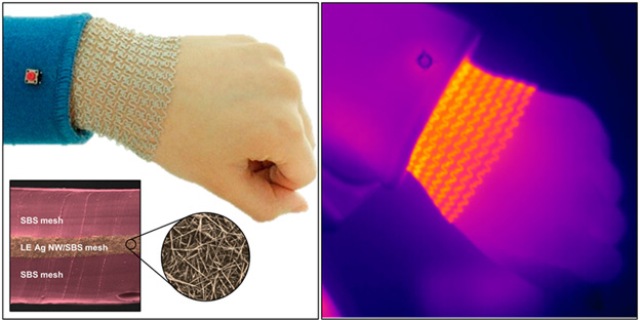Jul 6 2015
If you suffer from chronic muscle pain a doctor will likely recommend for you to apply heat to the injury. But how do you effectively wrap that heat around a joint? Korean Scientists at the Center for Nanoparticle Research, Institute for Basic Science (IBS) in Seoul, along with an international team, have come up with an ingenious way of creating therapeutic heat in a light, flexible design.

Other teams have come up with similar devices before, although no one was able to create something that didn’t rely on exotic materials or a complex fabrication process, factors which both carry hefty price tags. Unlike their predecessors, the team at IBS stayed away from things like carbon nanotubes and gold and looked at a more utilitarian option for their build material: thin slivers of silver nanowires.
The silver nanowires are tiny, averaging ∼150 nm in diameter and ∼30 μm in length (a human hair ranges from 17 to 181 µm). The nanowires were mixed into a liquid elastic material which is both soft and stretchy when dry.
To ensure that the material remains tight on the target area while heating, the team devised a 2-D interlocking coil pattern for the mesh structure. To make the mesh, the liquid mixture was poured into a shaped mold. The silver-elastic mesh was sandwiched between a top and bottom layer of soft, thin insulation.
In material flexibility tests, while placed on knee and wrist joints, the mesh heated while deformed and under stress on knee and wrist joints. It is lightweight, breathable and generates heat over the entire surface area of the material. A hot water bottle used for treating muscle soreness feels good, but it will inevitably cool down while in use. Commercially available electric heating pads are sufficient for applying heat to an injured area but their cords need to be attached to an A/C outlet to work. This is where the new technology trumps the old. The mesh maintains a constant temperature instead of cooling down during use and is battery powered so it doesn’t need an outlet.
Beyond thermotherapy, the applications are endless. This technology could be used as a lightweight heating element in ski jackets, or as a hyper-efficient seat warmer in a car. Although only flat mesh connected into a tube has been made so far, it isn’t a stretch to imagine creating more intricate designs like the shape of a hand with detailed fingers.